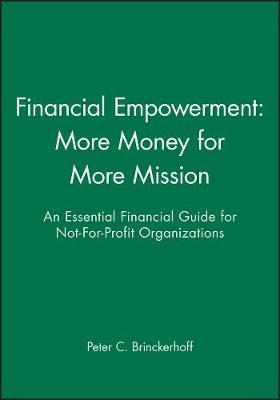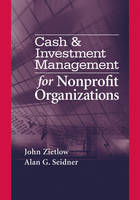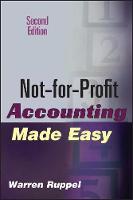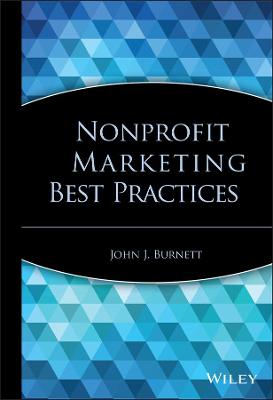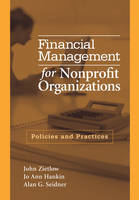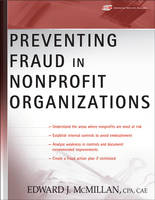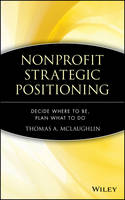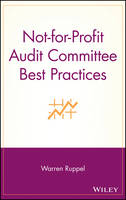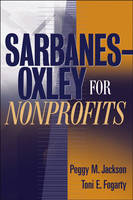Desktop Guide for Nonprofit Directors, Officers, and Advisors
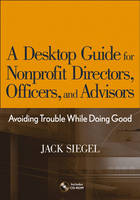 -15%
portes grátis
-15%
portes grátis
Desktop Guide for Nonprofit Directors, Officers, and Advisors
Avoiding Trouble While Doing Good
Siegel, Jack B.
John Wiley & Sons Inc
06/2006
744
Dura
Inglês
9780471768128
15 a 20 dias
1636
1.1 The Need for Action 6
1.2 Part of the Bigger Scheme 10
1.3 Assumption 11
1.4 Generality of Coverage 11
1.5 Using Qualified Professionals 11
1.6 Before Starting a New Organization 12
1.7 Concluding the Preliminaries 18
Chapter 2 Before Signing On 19
2.1 "Give, Get, or Get Off" 19
2.2 Ask Questions 20
2.3 Review Materials 21
2.4 Meet with the Executive Director and Other Officers 21
2.5 Review Other Resources 21
2.6 Step Aside if the Information Is Not Forthcoming 22
2.7 Your Role 22
Chapter 3 Organizational Basics 23
3.1 Nonprofit versus Tax-Exempt Status 24
3.2 The Corporate Form Is the Prevalent One 24
3.3 The Players 26
3.4 Organizational Documents 56
3.5 Meetings 63
3.6 Major Events 70
Chapter 4 Legal Duties and Obligations 77
4.1 A Well-Known Case 78
4.2 Director Duties and Responsibilities 80
4.3 Standards for Judging Behavior 84
4.4 The Standards as Applied to Common Decisions 88
4.5 Director Rights 98
4.6 A Further Look at Investment Decisions 99
4.7 Another Look at Conflicts of Interest 116
4.8 Moving from a Volunteer Director to a Paid Employee 125
4.9 Relief for Directors and Officers 128
4.10 Good Faith: A Storm on the Horizon for Nonprofit Directors 132
4.11 Avoiding Trouble As a Director 134
4.12 Avoiding Trouble As an Officer 135
4.13 The Litmus Test for Good Conduct 135
Chapter 5 Financial Statements, Internal Controls, and Sarbanes-Oxley 137
5.1 Where Accounting Rules Come From 140
5.2 The Three Nonprofit Financial Statements 141
5.3 Guidance for the Bookkeeper 155
5.4 Ratio Analysis 157
5.5 The Milwaukee Public Museum-What the Financial Information Foretold 161
5.6 Donor Insights into Financial Information 170
5.7 Auditor's Report 175
5.8 Audit Committee 176
5.9 GAO Audit Guidelines 181
5.10 Internal Controls 184
5.11 Financial Control Recommendations and Requirements for Recipients of Federal Funds 198
5.12 Fraud and Theft 199
5.13 Internal Fraud Detection 203
5.14 The Lone Perpetrator Accounts for the Highest Percentage of Frauds 204
5.15 Fraud and the Certified Audit 205
5.16 Sarbanes-Oxley Reforms 206
5.17 Summation: Steps for the Board 214
Chapter 6 Federal Tax Exemption 217
6.1 Tax-Exempt Entities 219
6.2 The Breakdown 225
6.3 A Detailed Look at Section 501(c)(3) Status 226
6.4 Obtaining Tax-Exempt Status 234
6.5 Private Inurement-The Prohibition 238
6.6 Intermediate Sanctions 240
6.7 Private Foundations 263
6.8 Political Activities 285
6.9 Lobbying 296
6.10 UBIT-Not All Income Is Tax Exempt 299
6.11 Reporting Requirements 317
6.12 Reporting and Withholding for Gambling Activities 322
6.13 Terrorism and the Nonprofit Sector 325
Chapter 7 Tax Aspects of Charitable Giving 329
7.1 Deduction Basics 330
7.2 Disclosures and Notices by Charities 346
7.3 Substantiation by the Donor and Appraisals 351
7.4 Planned Giving 355
Chapter 8 Other Benefits 375
8.1 Property Taxes 376
8.2 Sales Taxes-Purchases by Nonprofits 385
8.3 Sales Taxes-Sales by Nonprofits 387
8.4 Postal Nonprofit Standard Mailing Rate 388
8.5 Securities Offerings 397
8.6 Tax-Exempt Financing 398
8.7 Grants 400
8.8 "Do Not Call" Registry and Other FTC Limitations 400
8.9 Federal Funding for Faith-Based Organizations 403
8.10 Vendor Programs 410
8.11 Conclusions 410
Chapter 9 Registration and Reporting by Charitable Organizations 411
9.1 Registration: The Basics 411
9.2 Registration Is Constitutional 413
9.3 Lobbying 424
Chapter 10 Fundraising, Pledges, Gift Policies, and Restricted Gifts 429
10.1 Truth in Solicitation 430
10.2 Fundraising and Mission 433
10.3 Pledges 435
10.4 Restricted Gifts 441
10.5 Donor-Restricted Endowments 456
10.6 Changed Circumstances-Cy Pres and Equitable Deviation 466
10.7 Gift-Acceptance Policies 468
10.8 Bingo and Raffles 473
10.9 Federal Grants 474
Chapter 11 Avoiding Operational Liabilities 489
11.1 Avoiding Operational Liabilities from the Interaction of Core Activities with Organizational Culture 491
11.2 Avoiding Operational Liabilities through Record Retention Policies 497
11.3 Avoiding Operational Liabilities from Employment Practices 523
11.4 Avoiding Operational Liabilities from Volunteer Service 564
11.5 Avoiding Operational Liabilities from Service to Children 566
11.6 Avoiding Operational Liabilities in the Work Environment 572
11.7 Avoiding Operational Liabilities from Restraints on Trade-Antitrust 573
11.8 Avoiding Operational Liabilities Arising from Events 584
11.9 Avoiding Operational Liabilities from Conference Hotels and Rented Facilities 599
11.10 A Lesson from the Federal Sentencing Guidelines 599
Chapter 12 Risk Shifting, Indemnification, and Insurance 601
12.1 Relationship between Indemnification and D & O Insurance 602
12.2 Indemnification 603
12.3 D & O Insurance 607
Chapter 13 Evaluating Your Organization 653
13.1 The Self-Assessment Survey 654
13.2 Using Metrics to Evaluate Your Organization 667
13.3 Independent Review Standards 679
13.4 Grantor Review Standards 685
Chapter 14 A Final Thought 689
Index 693
1.1 The Need for Action 6
1.2 Part of the Bigger Scheme 10
1.3 Assumption 11
1.4 Generality of Coverage 11
1.5 Using Qualified Professionals 11
1.6 Before Starting a New Organization 12
1.7 Concluding the Preliminaries 18
Chapter 2 Before Signing On 19
2.1 "Give, Get, or Get Off" 19
2.2 Ask Questions 20
2.3 Review Materials 21
2.4 Meet with the Executive Director and Other Officers 21
2.5 Review Other Resources 21
2.6 Step Aside if the Information Is Not Forthcoming 22
2.7 Your Role 22
Chapter 3 Organizational Basics 23
3.1 Nonprofit versus Tax-Exempt Status 24
3.2 The Corporate Form Is the Prevalent One 24
3.3 The Players 26
3.4 Organizational Documents 56
3.5 Meetings 63
3.6 Major Events 70
Chapter 4 Legal Duties and Obligations 77
4.1 A Well-Known Case 78
4.2 Director Duties and Responsibilities 80
4.3 Standards for Judging Behavior 84
4.4 The Standards as Applied to Common Decisions 88
4.5 Director Rights 98
4.6 A Further Look at Investment Decisions 99
4.7 Another Look at Conflicts of Interest 116
4.8 Moving from a Volunteer Director to a Paid Employee 125
4.9 Relief for Directors and Officers 128
4.10 Good Faith: A Storm on the Horizon for Nonprofit Directors 132
4.11 Avoiding Trouble As a Director 134
4.12 Avoiding Trouble As an Officer 135
4.13 The Litmus Test for Good Conduct 135
Chapter 5 Financial Statements, Internal Controls, and Sarbanes-Oxley 137
5.1 Where Accounting Rules Come From 140
5.2 The Three Nonprofit Financial Statements 141
5.3 Guidance for the Bookkeeper 155
5.4 Ratio Analysis 157
5.5 The Milwaukee Public Museum-What the Financial Information Foretold 161
5.6 Donor Insights into Financial Information 170
5.7 Auditor's Report 175
5.8 Audit Committee 176
5.9 GAO Audit Guidelines 181
5.10 Internal Controls 184
5.11 Financial Control Recommendations and Requirements for Recipients of Federal Funds 198
5.12 Fraud and Theft 199
5.13 Internal Fraud Detection 203
5.14 The Lone Perpetrator Accounts for the Highest Percentage of Frauds 204
5.15 Fraud and the Certified Audit 205
5.16 Sarbanes-Oxley Reforms 206
5.17 Summation: Steps for the Board 214
Chapter 6 Federal Tax Exemption 217
6.1 Tax-Exempt Entities 219
6.2 The Breakdown 225
6.3 A Detailed Look at Section 501(c)(3) Status 226
6.4 Obtaining Tax-Exempt Status 234
6.5 Private Inurement-The Prohibition 238
6.6 Intermediate Sanctions 240
6.7 Private Foundations 263
6.8 Political Activities 285
6.9 Lobbying 296
6.10 UBIT-Not All Income Is Tax Exempt 299
6.11 Reporting Requirements 317
6.12 Reporting and Withholding for Gambling Activities 322
6.13 Terrorism and the Nonprofit Sector 325
Chapter 7 Tax Aspects of Charitable Giving 329
7.1 Deduction Basics 330
7.2 Disclosures and Notices by Charities 346
7.3 Substantiation by the Donor and Appraisals 351
7.4 Planned Giving 355
Chapter 8 Other Benefits 375
8.1 Property Taxes 376
8.2 Sales Taxes-Purchases by Nonprofits 385
8.3 Sales Taxes-Sales by Nonprofits 387
8.4 Postal Nonprofit Standard Mailing Rate 388
8.5 Securities Offerings 397
8.6 Tax-Exempt Financing 398
8.7 Grants 400
8.8 "Do Not Call" Registry and Other FTC Limitations 400
8.9 Federal Funding for Faith-Based Organizations 403
8.10 Vendor Programs 410
8.11 Conclusions 410
Chapter 9 Registration and Reporting by Charitable Organizations 411
9.1 Registration: The Basics 411
9.2 Registration Is Constitutional 413
9.3 Lobbying 424
Chapter 10 Fundraising, Pledges, Gift Policies, and Restricted Gifts 429
10.1 Truth in Solicitation 430
10.2 Fundraising and Mission 433
10.3 Pledges 435
10.4 Restricted Gifts 441
10.5 Donor-Restricted Endowments 456
10.6 Changed Circumstances-Cy Pres and Equitable Deviation 466
10.7 Gift-Acceptance Policies 468
10.8 Bingo and Raffles 473
10.9 Federal Grants 474
Chapter 11 Avoiding Operational Liabilities 489
11.1 Avoiding Operational Liabilities from the Interaction of Core Activities with Organizational Culture 491
11.2 Avoiding Operational Liabilities through Record Retention Policies 497
11.3 Avoiding Operational Liabilities from Employment Practices 523
11.4 Avoiding Operational Liabilities from Volunteer Service 564
11.5 Avoiding Operational Liabilities from Service to Children 566
11.6 Avoiding Operational Liabilities in the Work Environment 572
11.7 Avoiding Operational Liabilities from Restraints on Trade-Antitrust 573
11.8 Avoiding Operational Liabilities Arising from Events 584
11.9 Avoiding Operational Liabilities from Conference Hotels and Rented Facilities 599
11.10 A Lesson from the Federal Sentencing Guidelines 599
Chapter 12 Risk Shifting, Indemnification, and Insurance 601
12.1 Relationship between Indemnification and D & O Insurance 602
12.2 Indemnification 603
12.3 D & O Insurance 607
Chapter 13 Evaluating Your Organization 653
13.1 The Self-Assessment Survey 654
13.2 Using Metrics to Evaluate Your Organization 667
13.3 Independent Review Standards 679
13.4 Grantor Review Standards 685
Chapter 14 A Final Thought 689
Index 693

